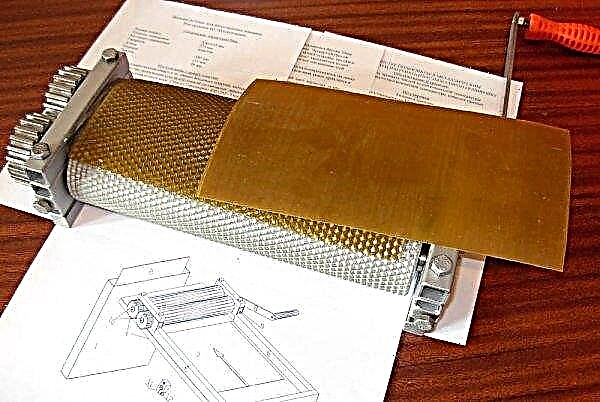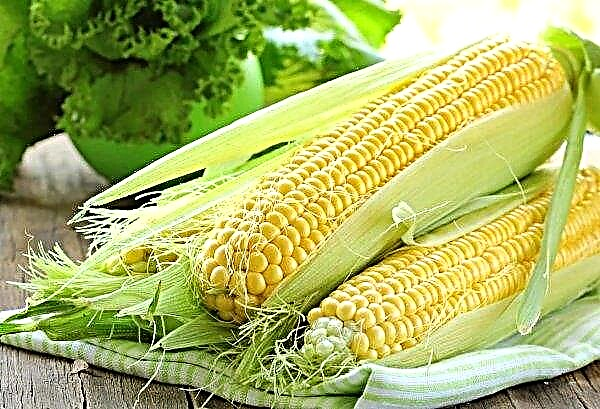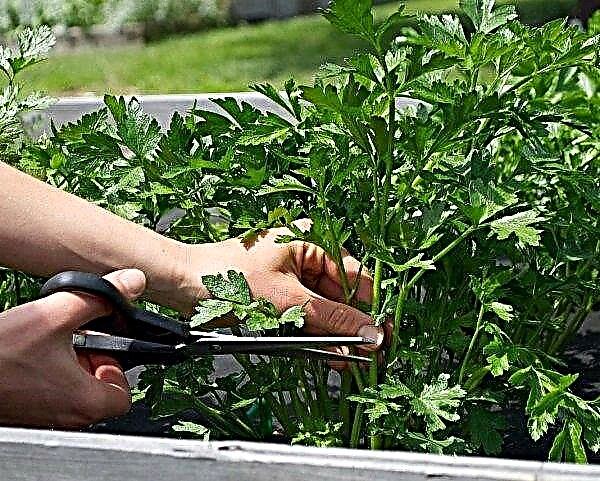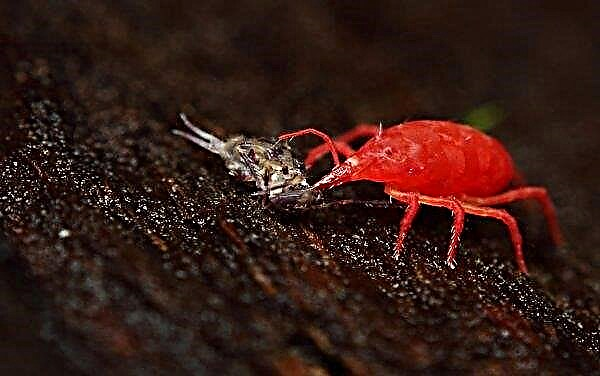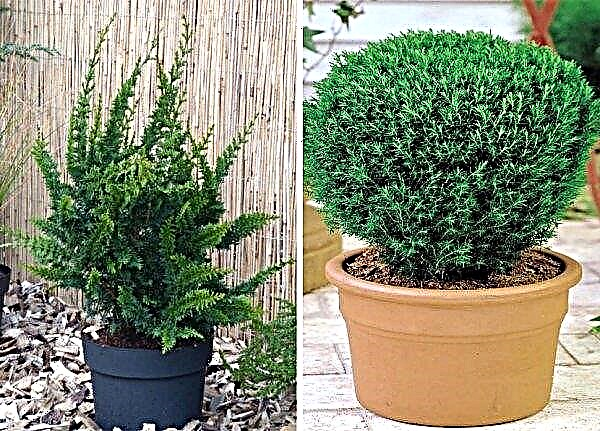Onion nematode is one of the most dangerous pests of vegetable crops. What type and type of parasite looks like, read below.
Parasitization of the onion nematode
The stem nematode has a wide distribution area, parasites are found in all countries of Europe and the Balkan Islands. It is impossible to parasitize the worm in the harsh climate of the northern regions of Russia, in Antarctica, as well as in the hot climate of the tropics. Features of the nematode parasitism are in their taste preference, because for the resettlement and reproduction of offspring, the worm selects only onion and garlic crops. The pest settles mainly on heavy soils.
Did you know? Nematode emits a toxic substance, leading to clogging of blood vessels and thickening of plant tissue.
How to recognize an onion nematode
Onion nematode belongs to the representatives of roundworms of the animal kingdom. The pest lives in the surface layers of the earth, where its number can be more than a million individuals per 1 m³, while the nematode plays an important role in the development of the ecosystem.
The body structure of the worm:
- unsegmented;
- round in cross section;
- threadlike form;
- length up to 2 mm;
- color is white, cream.
 It feeds with the help of a stylet, which is located in the front of the body, the pest pierces the soft tissues of the plant and sucks the juice. Larvae have a similar structure with adult individuals and differ in microscopic sizes - up to 0.4 mm.
It feeds with the help of a stylet, which is located in the front of the body, the pest pierces the soft tissues of the plant and sucks the juice. Larvae have a similar structure with adult individuals and differ in microscopic sizes - up to 0.4 mm.The nuances of life
Nematodes infect stems and leaf plates, live in seeds, parasitization in the root system is rare. The pest is introduced into the culture through the stomata and multiplies in living tissues. The pest is resettled by active movement in the ground or by using untreated tools to work in the garden.
Did you know? The onion nematode is very mobile, it is able to cover a distance of 2 m to the upper layers of the soil. To overcome 10 cm, the pest spends an average of 3 hours.
The life cycle is a maximum of 75 days, daily the female is able to lay 10 eggs. The most favorable conditions for laying are temperature from + 5 ° С to + 18 ° С. Larvae undergo 4 stages of development, each of which lasts from 3 to 5 days. At the last stage of development, the larvae are able to independently creep out from dead cultures in search of new hosts.
The total larval development period in the carrier plant is 23 days; during the growing season, 4 generations of nematodes are born, which hatch from the ovipositor one after another with an interval of 4 weeks. Worms have the ability to persist in soil for up to 1.5 years at temperatures from + 3 ° C to -5 ° C without a host plant. In the dry remains of vegetation, the pest continues to live up to 12 months.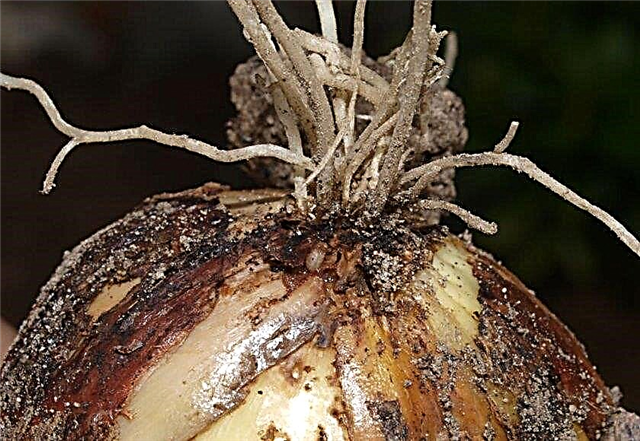
Symptoms of infection with onion nematodes
Infected plants generally have damage to leaf blades that thicken and twist, and then become dull and gradually turn yellow. Inside, the fruits become soft, losing elasticity and tissue integrity.
Important! The minimum density of soil infection by a nematode is 20 individuals per 1 kg, with a higher ratio, onion cultivation is not recommended.
Symptoms of onion infection:
- Leaf plates turn yellow, dry out, cracks appear.
- Matured vegetables are small, deformed. The core of the fruit becomes loose, acquires a brown tint, has a rotten smell.
- The defeat of the culture by worms at the initial stages of growth and development leads to improper formation of fruits, which is manifested by bloating of internal scales.
- The defeat of plant parasites at the final stage of growth leads to the formation of whitish spots on the scales of the vegetable.
- The presence of a rotten smell from the beds during irrigation and in rainy weather.

Parasite
The most dangerous pests of garden crops are the small nematode worms. Parasites are distinguished by their voracity, eating culture from the stem to the rhizome. The result of worm wrecking in the garden is:
- poor plant germination
- stalk deformation;
- developmental slowdown;
- poor harvest or lack thereof.
Important! If storage rules for onion crops are not followed, nematodes continue to grow and develop.
Ways to deal with a dangerous pest
Pest control is carried out in the following ways:
- crop rotation compliance;
- careful selection of material for sowing;
- use of insecticides;
- folk methods.
Compliance with crop rotation is the annual planting of onion crops in a new place, which will avoid infection of the crop with parasites. If nematodes were detected in the soil, then onion cultivation in this area is prohibited for 4 years due to the ability of the parasites to fall into suspended animation for a period of 2-3 years and patiently wait for the carrier plant.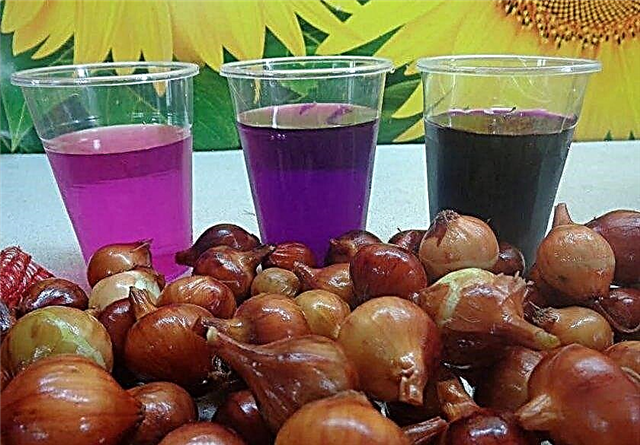 Planting material must be healthy and processed in a solution of potassium permanganate 1% for 8 hours immediately before planting in the ground. Effective is a dry treatment for disinfection, which consists in heating the seed material by exposure to direct sunlight.
Planting material must be healthy and processed in a solution of potassium permanganate 1% for 8 hours immediately before planting in the ground. Effective is a dry treatment for disinfection, which consists in heating the seed material by exposure to direct sunlight.
Chemicals
Using chemicals to control the nematode is the most effective method. To achieve the desired effect, it is necessary to use the substance nematicide, which is part of the chemicals.
Important! When carrying out treatment with hot water, do not exceed the temperature limit of + 55 ° C so as not to harm the plant.
There are a number of drugs that affect the respiratory tract of insects:
- "Methyl bromide";
- "Nemagon."
Contact preparations penetrating the skin:
- "Karbofos";
- "Phosphamide."

Folk ways
There are many ways to get rid of the nematode on the site without using chemicals. The most common is soil treatment with hot water:
- It is necessary to dig up infected cultures.
- Pour water heated to + 55 ° C into prepared containers.
- Plant disinfection is carried out for 5 minutes.
Effective in the fight against parasite infusion of marigolds:
- A pound of crushed marigold flowers pour 5 liters of boiling water.
- Insist 48 hours.
- Strain through cheesecloth.
- Use infusion in an amount of 200 g per each bed.

Infusion of Nasturtium:
- Grinded nasturtium in an amount of 300 g pour 5 l of boiling water.
- Insist for 24 hours.
- Strain, complete the treatment 3 times with an interval of 7 days, 300 g per well.
Preventive measures
Preventive measures:
- Disinfection of equipment used in tillage at the site.
- Harvesting weeds, loosening the soil.
- Careful selection and disinfection of planting material.
- Compliance with crop rotation.
- Cleaning the site after harvest, which consists in burning all plant residues of vegetables and weed grass.
The onion nematode is a microscopic parasite, which is characterized by extraordinary voracity and vitality, which makes it difficult to eradicate from the soil. To avoid problems with the pest, preventive measures should be carried out annually, as well as monitor the rotation of garden crops.





